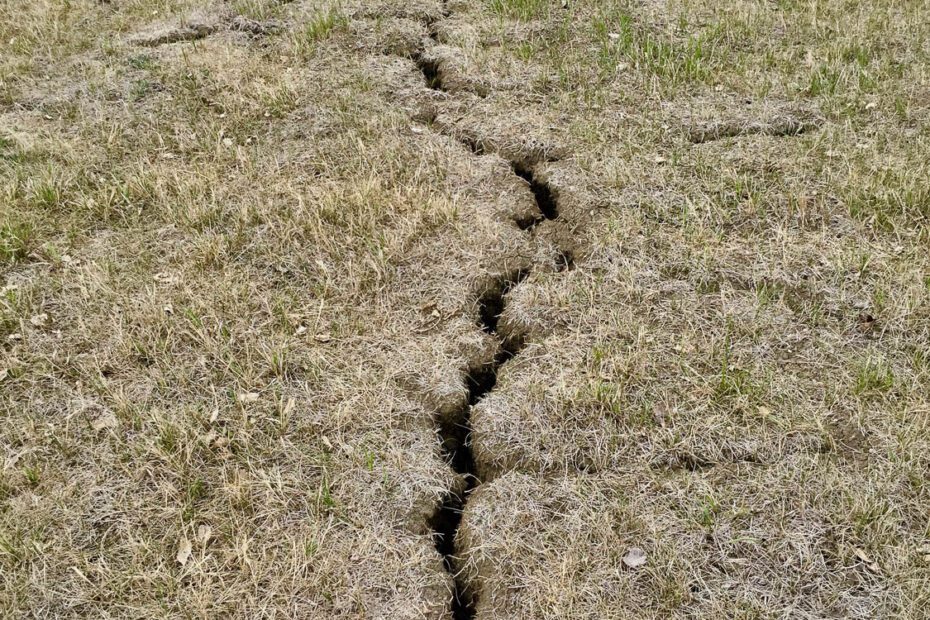Unbeknownst to many, beneath our feet lies the humble grassy carpet that silently withstands the test of time, gracefully embracing our every tread. Yet, even the most resilient lawns bear scars from the inevitable wear and tear. Like delicate porcelain marred by the passage of life, these tiny rifts appear as cracks in our verdant landscapes, gradually evolving into gaping chasms. But fear not, for there is a way to restore harmony to nature’s green tapestry. In this article, we delve into the secrets of cracking the code – that is, fixing those pesky crevices that have come to mar our lawns, granting us a renewed sense of tranquility, and allowing our grass to once again sing with the exuberance of life. So bid farewell to the eyesores that plague your turf, as we embark on an enlightening journey to fix cracks in your beloved lawn.
Detecting and Diagnosing Cracks in Your Lawn
Cracks in your lawn can be a frustrating sight, but fear not, for there are ways to detect and diagnose these troublesome imperfections. A keen eye for detail is key when it comes to identifying cracks in your lawn. Take a stroll through your yard and carefully inspect the ground for any visible signs of cracking. Keep an eye out for unevenness, depressions, or raised areas, as these can indicate the presence of cracks beneath the surface. Additionally, pay attention to any unusual changes in the color or texture of the grass, as these may also be indications of underlying cracks that need your attention.
Once you have successfully detected the cracks, the next step is to diagnose their causes. Understanding the root of the problem will help you determine the most effective solution. Some common causes of cracks in lawns include improper watering, compacted soil, and the presence of invasive plant species. Insufficient watering can cause dryness and shrinkage in the soil, leading to cracks. Compacted soil prevents proper water absorption and restricts root growth, resulting in weakened grass and the formation of cracks. Similarly, invasive plant species can compete for nutrients, water, and space, causing stress to the lawn and potentially leading to cracking. By diagnosing the cause of the cracks, you will be more equipped to handle the necessary repairs and ensure a healthy, crack-free lawn.
| Features | Tips |
|---|---|
| Use a moisture meter: This handy tool can help you determine if your lawn is adequately watered, preventing unnecessary dryness and cracking. | Apply lawn aerator: Regularly aerating your lawn can help alleviate soil compaction, allowing for better water absorption and reducing the likelihood of cracks. |
| Overseed bare patches: Sprinkling grass seeds on bare areas helps promote healthy growth, filling in cracks and preventing any further damage. | Inspect drainage: Ensure that your lawn has proper drainage to prevent excess water accumulation, which can weaken the soil and lead to cracking. |
| Fertilize regularly: Providing your lawn with essential nutrients through regular fertilization strengthens the grass, making it more resilient against cracking. | Control invasive plants: Removing invasive species from your lawn will reduce competition for resources and prevent potential damage to the grass, thus minimizing the risk of cracks. |

Best Practices for Repairing Cracks in Your Lawn
Do you have unsightly cracks in your otherwise beautiful lawn? Don’t worry, we’ve got you covered with some excellent tips and tricks to help you fix them up and restore the lushness of your green space!
First, it’s important to understand what causes these cracks in the first place. Factors like temperature fluctuations, excessive dryness, soil compaction, and the presence of invasive weeds can all contribute to the formation of cracks. But fear not, because with the following best practices, you can bring your lawn back to life and prevent future cracks from appearing:
| Features | Tips |
|---|---|
| Fertilizing | Regularly fertilize your lawn to provide it with essential nutrients, promoting healthy grass growth and preventing cracks. |
| Aerating | Aerate your lawn to alleviate soil compaction, allowing water and nutrients to reach the roots more efficiently. |
| Seeding | Overseed the cracked areas with appropriate grass seed to encourage new growth, filling in the gaps and reducing the appearance of cracks. |
Additionally, ensuring proper watering and drainage, mowing at the correct height, and removing weeds promptly are all crucial aspects of crack prevention and repair. By following these best practices, you’ll soon have a rejuvenated lawn that will be the envy of the neighborhood!

Effective Tools and Techniques for Resolving Lawn Cracks
<p>If you find unsightly cracks in your lawn, worry not, as there are several effective tools and techniques to help you restore its pristine beauty. Fixing cracks in your lawn not only enhances its visual appeal but also promotes healthier growth and prevents further damage. Whether your lawn is plagued by small cracks or large fissures, here are some ingenious tips and features to aid you in the restoration process.</p>
<p><strong>1. Aeration Tools:</strong> Aeration is a crucial step in addressing lawn cracks as it allows proper water and nutrient absorption, which aids in sealing the cracks. Utilize a manual or mechanical aerator to create small holes in the soil, enabling better air circulation and reducing compaction. This prepares the ground for the next steps in your lawn repair journey.</p>
<p><strong>2. High-Quality Topsoil:</strong> Introduce <a href="https://up-gardening.com/when-to-level-bermuda-lawn/" title="When to Level Bermuda Lawn">high-quality topsoil</a> into the cracks to fill them up. Ensure the topsoil is evenly spread and gently press it down to create a level surface. The topsoil aids in nourishing the grass roots and provides an excellent medium for new growth. Regularly watering the patched areas is vital to promote seed germination and the establishment of healthy grass.</p>
<table>
<tr>
<th>Features</th>
<th>Tips</th>
</tr>
<tr>
<td>Grass Seed</td>
<td>Choose a grass seed mix that suits your specific lawn type and climate for optimal results.</td>
</tr>
<tr>
<td>Ground Cover Mats</td>
<td>Consider using biodegradable ground cover mats to prevent soil erosion and assist in seed germination.</td>
</tr>
<tr>
<td>Fertilizer</td>
<td>Use a slow-release fertilizer to nourish the lawn over an extended period, aiding in growth and repair.</td>
</tr>
</table>
<p>By employing these effective tools, techniques, and features in resolving lawn cracks, you'll soon witness a remarkable transformation in your lawn's overall health and appearance. Remember to stay consistent with lawn maintenance to ensure long-term benefits and a robust, vibrant lawn for years to come.</p>
Preventive Measures to Minimize Cracks in Your Lawn
Having a well-maintained lawn adds to the beauty of your home. Unfortunately, cracks in the lawn can be an eyesore and also lead to other problems such as weed growth and uneven surfaces. However, with these preventive measures, you can minimize cracks and keep your lawn looking lush and healthy:
- Regularly water your lawn: Proper hydration is crucial in preventing cracks. Ensure that your lawn receives enough water to keep the soil moist. However, be cautious not to overwater as it can lead to shallow root growth and increase the risk of cracks.
- Mow at the correct height: Adjust your lawnmower to cut the grass at the recommended height. Taller grass shades the soil, reduces evaporation, and prevents it from drying out, which can contribute to cracks.
- Avoid heavy traffic: Limiting foot traffic and any heavy machinery on your lawn will prevent soil compaction. Compacted soil is more prone to cracking, so encourage family members to use designated areas and avoid unnecessary walking or playing on the grass.
| Feature/Tips | Description |
|---|---|
| Proper soil preparation | Ensure that your soil is adequately prepared before laying new turf or planting grass seeds. Proper soil preparation improves the overall health and stability of the lawn. |
| Regular aeration | Aerating your lawn annually helps reduce soil compaction and allows necessary oxygen, water, and nutrients to reach the grassroots, minimizing the risk of cracks. |
| Apply organic fertilizers | Using organic fertilizers instead of synthetic ones promotes healthier soil and grass growth. Strong, vibrant grass is more resilient, reducing the likelihood of cracks. |
By following these preventive measures and incorporating the mentioned features into your lawn care routine, you can minimize cracks and ensure a picture-perfect, crack-free lawn for years to come!
Frequently Asked Questions
Q: I’ve noticed a few unsightly cracks appearing in my lawn. What’s the best way to fix them?
A: Lawn cracks, those obnoxious intruders in our otherwise pristine greenspaces, can be banished with a little tender love and care. Here are three pro tips to restore your lawn’s flawless façade:
Q: How can I prepare and clean the cracks before repairing them?
A: Before embarking on the epic quest to mend your lawn’s cracks, prepare it for battle by cleaning the affected area. Begin by evicting any debris from the cracks, giving them a good sweep or spray. Once cleared, scrub away any loose or dead grass, taking care to create a smooth, crack-free canvas.
Q: What are the best methods for repairing cracks in the lawn?
A: Armed with a cleaned battlefield, fearless homeowner, you can proceed to the most important phase of your crusade: crack repair. Options abound! You may choose to arm yourself with specialized lawn patching compounds, as they effortlessly fill small breaches. For those larger, more ominous ravines, don’t underestimate the warrior’s might of a reliable lawn soil mix. Simply apply it to the cracks and tamp it down like a seasoned soldier. And remember, dear warrior, to water and nurture your newly filled cracks like small seedlings, ensuring seamless integration with the rest of the lawn.
Q: How can I prevent cracks from reappearing in the future?
A: Ah, the eternal question of prevention! Once victorious in your battle against existing cracks, fortify your lawn defences to ward off potential future invaders. Encourage strong root growth by practicing regular lawn aeration, allowing the grass roots to strengthen, toiling tirelessly to keep your lawn whole. Remember also to keep a vigilant eye on the water supply, providing deep, slow watering to maintain the soil’s moisture balance. Finally, let us not forget the importance of mowing at the correct height, my aspiring turf champions. Ensure you don’t trim your lawn too short, allowing the grass blades to shade the soil, protecting it from the scorching blaze of the sun.
With these valiant efforts, future cracks will tremble in fear and retreat, leaving your lawn a triumphantly crack-free sanctuary. You, dear lawn warrior, have emerged victorious in your quest to restore the natural beauty of your green kingdom! As we come to the end of our journey in tackling those pesky lawn cracks, let us pause for a moment to appreciate the beauty that lies ahead. The once-blemished landscape now boasts a refined glory, thanks to your efforts and a touch of Mother Nature’s grace.
Remember, repairing cracks in your lawn is not merely an act of restoration but a testament to your commitment to nurturing nature’s wonderland. As the seasons unfold, each blade of grass will intertwine and dance harmoniously, leaving no trace of the cracks that once marred the earth.
Now that you possess the knowledge and tools to combat these little crevices, go forth with newfound confidence and let your lawn radiate its grandeur. As with any masterpiece, it may require occasional touch-ups, but that’s the nature of the ever-evolving canvas beneath your feet.
Take pride in the transformation you have accomplished, adding your own unique brushstrokes to the living artwork that is your lawn. From patching up cracks that dared to interrupt the pristine green, to fostering a sanctuary for nature’s creatures both great and small, you have become a steward of the earth.
So, dear reader, may your days be filled with the scent of freshly cut grass, the vibrancy of flourishing flowers, and the joy of knowing that you have breathed new life into your once-fragile turf. And when the sun sets, casting its warm glow upon your perfected paradise, may you find solace in its beauty, as your troubles melt away, like a distant memory of a forgotten crack.
- When to Put Weed and Feed on Lawn in Michigan - October 16, 2023
- When to Fertilize Potatoes Plants - October 16, 2023
- Can You Plant Clover in the Spring - October 16, 2023

